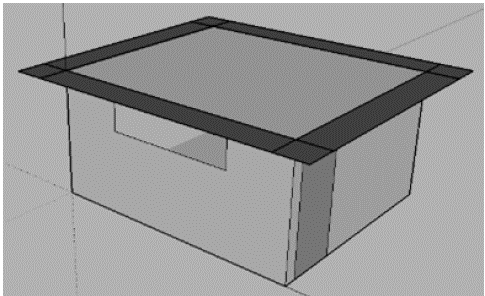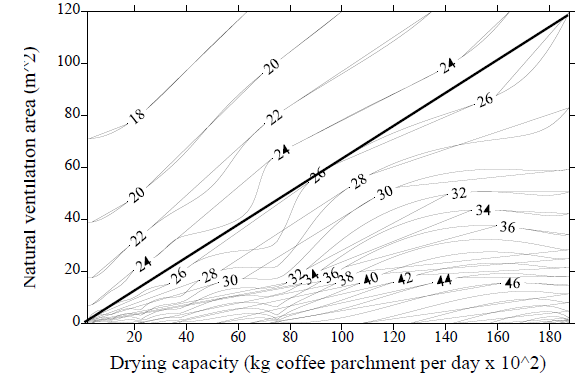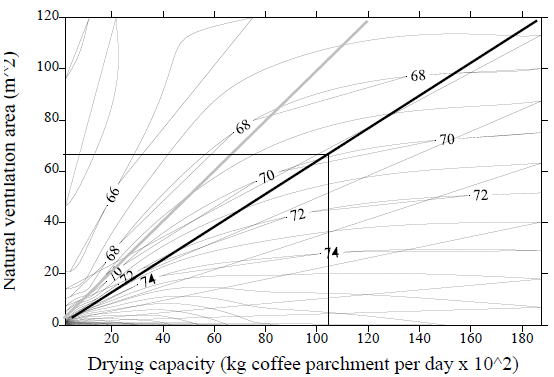1. Introduction
Coffee is one of the most popular beverages in the world, and has great economic and social importance [1-2] In addition, global coffee consumption has also risen at an average annual rate of 1.9% over the past 50 years [3].
Coffee plants are grown in tropical and subtropical regions of Central and South America, Africa and South East Asia, mainly in regions with temperate and humid climates [4]. Latin America produces more than half the world’s coffee, with Brazil and Colombia as the first and third highest producers, respectively [5].
High-quality coffee requires special care and handling from the pre-harvest phase, through harvest, to post-harvest. In these phases, several factors may cause changes that may affect the future drink. Producing coffees of better quality means a good differential of product price and hence more profit for the producer [5]. Specifically, the post-harvest coffee process is one of the primary points for the preservation of coffee bean quality [6].
In regions like Colombia, Central America and Hawaii, Arabica coffees are processed via the wet method, where only mature coffee cherries are harvested and pulped to remove the exocarp and mesocarp. Subsequently, the thin mucilaginous layer surrounding the coffee seeds is removed either via a natural fermentation process or mechanically. Finally, the coffee beans are sun-dried or mechanically to a moisture content of 11-12% so as to achieve microbial stability [7-11]
In post-harvest treatment of coffee, the drying occupies one of the most important roles from an energetic effort point of view. If this process is badly performed, microorganism can grow on the coffee bean surface, exposing it to biochemical reactions that could affect sugar content [12]. The main problems in the taste of cup arise from poor drying and storage. Development of microorganisms is a factor in the environment that arises only when adverse storage conditions permit excessive moisture accumulation in the grain bulk or when grain is stored initially above the permissible safe moisture contents required for its preservation [13].
Microbial contamination can occur in the cherries and during harvesting, fermentation, drying and storage of the coffee beans [14]. Bacteria, yeasts and filamentous fungi have already been reported in the pulp and beans of coffee processed in Brazil, India, Hawaii, Congo, Argentina, Colombia, Costa Rica, Ethiopia and Mexico [14]. In terms of flavor and aroma of the beverage, filamentous fungi predominate at the end of the processing period and during storage, but also present a safety risk for the final product, due to the production of toxic secondary metabolites, the mycotoxins, which can be harmful to consumers at certain concentrations [15].
The bioclimatic conditions of the place where the parchment coffee is stored are very important. Fungi live and reproduce best between 70 and 80% relative humidity, whereas yeast and bacterial development require humidities higher than 85% in the intergranular air [16]. The biological risk is latent in facilities’ wet processing of coffee; for example, according to [17], Aspergillus ochraceus (a leading producer of Ochratoxin A) was found in 70% of the facilities tested in Colombia, in the facilities’ post-harvest coffee, solar dryers, coffee parchment and green coffee. This author argues that only when adequate conditions of humidity, temperature, time and unhygienic conditions occur, can these microorganisms proliferate.
On the other hand, temperatures above 50 °C can kill the seed of coffee and begin its process of decomposition. In the tropical zone, with relative humidity above 70% and temperatures higher than 27 °C, freshly harvested beans and processed grains can be attacked by insects common in storage [16].
Farmers, particularly to remote farmers, often keep store parchment or green-bean coffee for long periods before it can be transported to a sale point [18]. In the humid/rainy conditions, moisture can build up in stored beans, promoting fungi and bacteria development [16].
Approximately 70% of the volume of coffee that is produced in Colombia is dried mechanically [19]. This process usually generates a lot of steam and heat into the facilities where the coffee is dried. In the post-harvest coffee, the largest power consumption occurs in the mechanical drying process, with efficiency of 50% [20], The fact that machines are generating heat inside the agroindustrial buildings reinforces the importance of natural ventilation and its beneficial effect on the removal of water vapor [21] generated from the perspiration of the occupants and particularly the drying process, which can lead to biologically dangerous conditions for the preservation of quality coffee.
Natural ventilation is an effective method for improving indoor air quality and reducing energy consumption in buildings, especially when the indoor temperature is close to or higher than the temperature of the external environment [22-24]. The natural ventilation strategies design is often disregarded as there are no standards available to support designers in the design of natural ventilation openings [25].
A poor control and design of buildings for the wet processing of coffee can compromise product quality due to inadequate bioclimatic environments [26] The bioclimatic approach of buildings in tropical warm and wet regions requires previous bioclimatic work, analyzing the envelope of building to limit the power contributions and to optimize the flow of air from natural ventilation [27].
Computational modeling of natural ventilation related to energy consumption and thermal comfort has been carried out using different methods: for example, fuzzy control algorithms have been used, combining indoor air quality that is acceptable to thermal comfort with good results [25], as well as computational fluid dynamics modeling (CFD) to analyze the flow field and turbulence [28]. Zonal and network models have also been used, in programs such as EnergyPlusTM [29].
[26] and [18] performed bioclimatic analysis for a parabolic solar dryer and wet mill of coffee facilities through simulations in the EnergyPlusTM program. These authors, were found that the greater the area of natural ventilation, is lower temperature and relative humidity inside these facilities, but in the no such relationship has been found, nor is there any recommendation for the minimum natural ventilation area necessary to maintain a suitable bioclimatic environment for different scales of coffee production.
Taking into consideration facilities that varied in the size of production, and using the EnergyPlusTM program, this study aimed to find the minimum area of natural ventilation suitable for coffee processing wet facilities in Colombia that have mechanical drying inside, in order to preserve the quality of coffee through a bioclimatic environment conducive to biological safety.
2. Material and methods
This study was conducted taking into account the conditions of the coffee region of Antioquia, Colombia. For these simulations the climate file of its capital Medellin (at coordinates 6°14’41”N 75°34’29”W, altitude of 1500 m) - which has a climate representative of this coffee zone was used. The internal environment of the buildings was simulated for the month of November, during the main harvest of the year, which coincides with the second rainfall season in this part of Colombia [30].
Table 1 Thermal properties of materials

ρ: density, λ: thermal conductivity, Cp: specific heat.
Source: Adapted from [36].
Using the program EnergyPlusTM, which is one of the most popular bioclimate simulation programs in the world [31], 118 computer simulations were performed for different sizes of production and different areas of ventilation, with mechanical drying inside with power (of heat exchanger) ranging from 26 kW to 1625 kW, and ventilation areas of 0 m2 to 120 m2, and with facilities with building volumes ranging from 28 m3 to 3200 m3. Data on drying power and volumes of buildings for wet coffee processing were provided by Comité de Cafeteros de Antioquia.
In engineering, all models are a simplified representation of reality, of complex physical or chemical phenomena in the world [32]. In this case, for the modeling, simple geometries of the buildings were assumed, orientation east-west, and drawn in the 3D geometries SketchUp® program, for each of the 118 different cases (Fig. 1).
For the thermal properties of the washing coffee, it was used equations 1 and 2 proposed by [33] for the specific heat (Cpc, J kg−1 °K−1 ) and density of the coffee (pc, kg m-3). These properties are functions of the moisture content of the product on a dry basis (Mdb, decimal dry basis).
To calculate the thermal properties of composite materials and the thickness and equivalent thermal resistance of the various construction materials [34], we used the simplified method of generating layers of materials [35].
For the calculation of the energy balance, it is necessary to calculate the heat generated within each building (heat generated by machines, lighting and human metabolism). Table 2 shows the power values of the machines and lighting.
It was assumed that the heat exchangers of the drying machines used coal (anthracite) as fuel, which, according to [20], has a consumption of 0.224 kg of coal per kg of dry parchment coffee, with a calorific value of 33440 kJ.kg-1.
For metabolic rate, the value of 423 W.person-1 was used in this study for the metabolic rate; according to [37], this value corresponds to heavy work activity and handling 50 kg sacks.
A statistical analysis was performed with a linear correlation matrix to observe the existence of a linear correlation between variables: drying capacity (kg of coffee parchment per day), building volume, natural ventilation area, mean temperature and mean relative humidity inside the facilities.
In addition, a mapping of the temperature and relative humidity variables related to the power drying machines and natural ventilation area was performed, applying the Kriging gridding method using the Surfer program. Finally, from the relationships drawn from these maps, a minimum area of natural ventilation was proposed to maintain the facilities with an adequate bioclimatic environment to preserve the quality of coffee.
3. Results and discussion
Table 3 shows the linear correlation matrix. It can be seen that there is a linear correlation between the capacity of the machines for drying coffee and the volume of the construction (building size), and the area of natural ventilation. This result is obvious, since the power of the machines, volume of the buildings and ventilation areas of actual installations were used.
Also, a direct linear correlation was observed between the internal temperature and capacity of the drying machines, and an inverse correlation between the capacity of the drying machines and the relative humidity inside the facilities. This is because, since the efficiency of these machines is 50% [20], this means that when the power increases, the thermal energy gain increases inside these buildings.
Table 3 Matrix linear correlation

CD: capacity of the machines for drying, V: volume, NVA: natural ventilation area, T: temperature, RH: relative humidity.
Source: the authors.
Furthermore, it is observed that the building volume didn’t have a significant linear correlation with the variables temperature and relative humidity; however, the area of natural ventilation presented a strong inverse linear correlation with temperature and relative humidity variables. This fact suggests that as the area of natural ventilation is increased, the temperature and relative humidity decreases, because facilitates the transfer of heat and steam (produced by drying process) to the outside.
Fig. 2 shows a map of isolines of temperature (°C) within the wet coffee processing facilities, in function of drying capacity of machines, and area of natural ventilation. A pattern can be observed showing that when the drying capacity increases, so the internal temperature of these facilities increases; on the other hand, as the area of natural ventilation increases, so the internal temperature decreases. [18] found a similar result for a parabolic solar coffee dryer.
In Fig. 2 a straight diagonal line separating the lower internal temperatures at 27 °C can also be seen, which it is the limit for safekeeping grains from insect attack [16]. This line is defined by equation 3, and suggests the minimum area of natural ventilation in function of the drying capacity of the machines inside the coffee processing facilities.
Where:
NVAm: Minimum area of natural ventilation (m2).
DP: Drying capacity (kg of coffee parchment per day).
Fig. 3 shows a map of isolines of relative humidity (%) inside the coffee processing facilities in function to the drying capacity of the machines, and the area of natural ventilation. Similar to the temperature variable, a pattern can be observed, which shows that as the drying capacity increases, so too does the internal relative humidity of these facilities increase. On the other hand, the area of natural ventilation increases, so the internal relative humidity decreases. [18] found a similar result for a parabolic solar coffee dryer.
It can be observed in general that the facilities may be more prone to fungal attack when there is a relative humidity of between 70 and 80% [16]; this is consistent with the study of [17] and [38].
In Fig. 3, two straight diagonal lines can also be observed separating relative humidities greater than 70%, in order to maintain safety in the grains [16]: the black line is defined by equation 3, and its application range is to higher capacities of up to 10500 kg dry parchment coffee per day. For smaller capacities (gray line), the minimum area of natural ventilation is defined by equation 4.
With a higher drying capacity the slope of the isolines relative humidity within the facilities decreases, and this can be explained by the fact that although the increasing drying capacity of the machines increases the emission of water vapor, it also increases its addition of thermal energy, and so the temperature and pressure saturation vapor, and thus the relative humidity trends to decrease.
The dimensions of natural ventilation openings are very important, but so is its location [21]. Because within in buildings for wet processing of coffee is generated large amount of heat and steam, it is recommended to take advantage of dynamic and thermal ventilation, using air inlets located on the bottom of the building, and air outlets located on top of the facility, in order to direct the airflow [22] warm and steam laden outside of the building. It is recommended future studies in CFD in this regard.
4 Conclusions
In facilities used for the wet processing of coffee, with drying machines inside, as the capacity of such machines is increased, so the internal temperature and relative humidity tends to increase, due to the addition of heat and steam inside.
There is an inverse linear correlation between the natural ventilation area in facilities used for the wet processing of coffee with drying machines inside, and the temperature and relative humidity inside.
Facilities with little area of natural ventilation are more prone to attack by filamentous fungi and insects in grain storage.
It is possible, by using the capacity of the coffee drying machines, to calculate the required minimum area of natural ventilation to reduce the biohazard inside coffee processing facilities.























